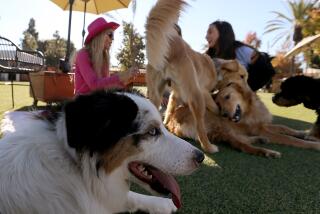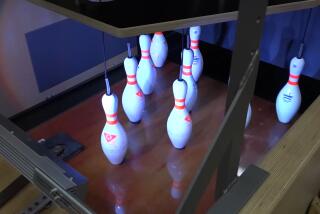When your dog’s bowl sends you e-mail
- Share via
Looking for a way to keep her dog Casey from feeling lonely while she’s at work, Tracy Jones plunked down $20 for a ball that acts as a virtual pet sitter. When it’s nudged, the ball dispenses treats and electronic reassurance via a prerecorded message that says -- in Jones’ voice -- “Good dog!”
Casey’s Talk to Me Treatball is part of a growing trend of high-tech and electronic products meant to make the owning of pets easier, more entertaining and more convenient. Browse pet store aisles and you’ll find programmable feeders, digital dog tags that store up to 40 lines of information in five languages, lightbulbs that promise to eradicate pet odors, and a huge array of sophisticated products that feed, clean up after and amuse pets with little human effort.
For the record:
12:00 a.m. Oct. 13, 2004 For The Record
Los Angeles Times Wednesday October 13, 2004 Home Edition Main News Part A Page 2 National Desk 1 inches; 31 words Type of Material: Correction
Pet products -- An article in Thursday’s Home section about high-tech pet products said they are the fastest-growing segment of the nearly $8-million-a-year pet-product market. Pet products are an $8-billion-a-year market.
High-tech pet products started taking off about five years ago and are now the fastest-growing segment of the nearly $8 million a year pet-product market, says Bob L. Vetere, executive vice president of the American Pet Products Manufacturers Assn. Most manufacturers have come up with some sort of high-tech device.
While bark “translators” such as the $80 Bowlingual and an $18 “PollyVision” DVD edited specifically for a captive bird’s viewing pleasure are mainly for fun and fascination, other gadgets are more practical.
“Electronic restraint systems keep animals safe and close by. Automatic water dispensers and timed feeding devices allow working people to leave pets for a whole day without worry,” Vetere says. “Products like that increase the market of potential pet owners because they allow many people to have pets who couldn’t care for one before.”
Self-cleaning litter boxes can take over the least pleasant task associated with owning a cat. A sensor detects when a cat has entered the box, then a rake collects and deposits the waste into a plastic dispenser. The product retails for around $100, so when Wendy Hand of Thousand Oaks found one on EBay for less than $80, she snapped it up.
“I have multiple cats, and cleaning the box twice a day was overwhelming,” she says. “It was always hanging over my head. Now ... the box is always clean.”
Mike Joehnk can also vouch for the practicality of such products. A La Jolla property manager, Joehnk makes sure that leaks are promptly fixed in the 500 apartments for which he’s responsible. But when his own bathtub faucet started dripping, he let it go for more than a year.
Blame Opie -- Joehnk’s cat. Seems the 5-year-old orange tabby got a kick out of licking droplets straight from the spout, and Joehnk didn’t have the heart to deny him. After fixing the drip, the pet owner spent about $50 on a fountain that provides a constant stream of clean, fresh, running water. “It was worth every penny,” Joehnk says.
Harvey Shapiro of Del Mar grooms Kaiko, his 12-year-old chocolate lab, with a battery-operated ionic hairbrush that Sharper Image sells for around $40. The brush releases small amounts of ozone and stays clean-smelling -- no matter what Kaiko rolls in. “It looks like a regular hairbrush, but I’m not transferring any stink back onto the dog,” says Shapiro, a retired professor of medicine at UC San Diego.
Not every high-tech pet product is so functional. Some can only be described as silly -- or superfluous. The solar-powered $20 Thirst Alert water bowl sets off a series of flashing red lights around the rim when water or food is gone. Andrew Naugher, who handles public relations for Thirst Alert, admits that it is probably just as easy to glance at the bowl to see whether it needs refilling.
“But where’s the fun in that?” asks Naugher, who uses the bowl in his home. “I’d rather have the surprise of seeing a glowing strand of dancing, effervescent red lights to remind me that my pet’s epicenter of nourishment and refreshment demands my immediate attention.”
Need an even more blatant reminder to feed Fido? A soon-to-be released deluxe Thirst Alert bowl, which should be in stores in time for Christmas shopping, will send the owner an e-mail or text message when the pet’s bowl is empty. Really, who would ever use such a thing?
Todd Ransom would. A friend gave Ransom a Thirst Alert bowl when he caught the West Hollywood publicist meticulously cleaning each of his dog’s dozen toys. “My dog is very special and persnickety, and anything that makes her more comfortable -- that’s what I want,” said Ransom, who shares his home with Madelyn, a 5-year-old black and tan cocker spaniel.
Charlotte Reed, a former corporate lawyer and owner of Two Dogs & a Goat, a New York City “pet consultancy” that offers pet advice, luxury products, grooming, training and pet sitting for 250 clients, believes that pet owners such as Ransom are simply looking for innovative ways to lavish love on their “fur-kids,” as she calls companion animals. “Pets offer us emotional support and unconditional love, so pet owners are willing to buy the best and newest products for their babies,” Reed says.
Sometimes, though, the products have unforeseen human benefits. Just ask Jones of Manhattan Beach. The sales manager for Busch brings the Talk to Me Treatball on beach outings with her dog. When she spots an attractive man on the sand, she tosses the toy in his direction and watches for his reaction when the bright red ball blurts out a flirtatious, “Hello. My owner thinks you’re cute.”
More to Read
Inside the business of entertainment
The Wide Shot brings you news, analysis and insights on everything from streaming wars to production — and what it all means for the future.
You may occasionally receive promotional content from the Los Angeles Times.










